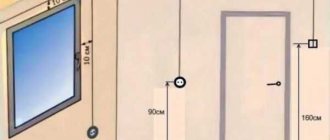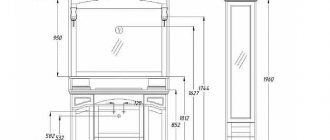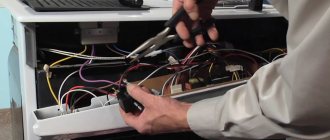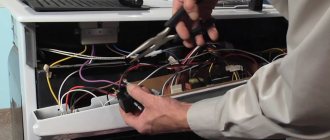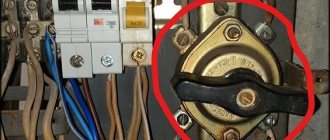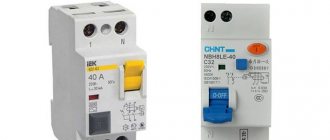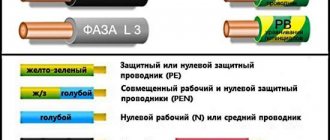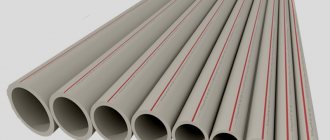Circuit breakers installed in apartment electrical panels are designed for emergency power outages in the event of a short circuit or excess load on the circuit. They can also be controlled manually when it is necessary to change the switch.
The markings of the circuit breakers, presented in the form of names, alphanumeric designations and diagrams, will tell you what parameters the device has. Agree, the ability to “read” the inscription will be useful to the home handyman if he needs to replace a device, fix breakdowns, or connect an additional machine.
We will help you figure out what's what. The article describes a detailed explanation of the marking block on the switches, and also provides recommendations for choosing a machine, taking into account its characteristics.
Decoding the designations of machines in the electrical panel
Electricity, if used incorrectly, can pose threats to the environment, health and human life. To eliminate such cases, rules for the use of electricity (PUE, national and international standards) have been put into effect, which oblige all power circuits to be equipped with protective devices. Among these elements are automatic switches. To choose them correctly, you need to understand the characteristics that are reflected in the labeling.
- General information about machines
- Marking of machines
- Tips for choosing a circuit breaker
Why is labeling necessary?
For a qualified electrician, the front panel of the machine is like an open book - in a couple of minutes he can find out everything about the device, from the manufacturer to the rated current value. An experienced installer can easily distinguish between devices that are absolutely identical from the point of view of the average person.
A homeowner unfamiliar with the intricacies of electrical wiring can also understand the information provided by the manufacturer.
Using special symbols located on the front panel, you can distinguish the machine from the RCD, find out its main technical characteristics and find out in what sequence the wires are connected.
Information about a separate circuit breaker may be required if:
- it is necessary to replace the device;
- you should select a new machine due to the appearance of an additional circuit;
- it is required to compare the rated current load of the line and the circuit breaker;
- you need to find the cause of the emergency shutdown, etc.
Some symbols become intuitive, while others require certain knowledge to decipher. If you are planning to replace the wiring yourself or connect a circuit breaker, it is better to study information about the devices in advance.
Electric machines. Types and work. Characteristics
From the very beginning of the emergence of electricity, engineers began to think about the safety of electrical networks and devices from current overloads. As a result, many different devices have been designed that are distinguished by reliable and high-quality protection. One of the latest developments is electric automatic machines.
This device is called automatic because it is equipped with a function to turn off the power in automatic mode in the event of short circuits or overloads. Conventional fuses must be replaced with new ones after tripping, and the circuit breakers can be turned on again after eliminating the causes of the accident.
Such a protective device is necessary in any electrical network circuit. A circuit breaker will protect a building or premises from various emergency situations:
- Fires.
- Electric shocks to a person.
- Electrical wiring faults.
Types and design features
It is necessary to know information about the existing types of circuit breakers in order to correctly select the appropriate device during purchase. There is a classification of electric machines according to several parameters.
Breaking capacity
This property determines the short circuit current at which the machine will open the circuit, thereby turning off the network and devices that were connected to the network. Based on this property, machines are divided into:
- 4500 ampere circuit breakers are used to prevent faults in the power lines of older residential buildings.
- At 6000 amperes, they are used to prevent accidents during short circuits in the network of houses in new buildings.
- At 10,000 amperes, used in industry to protect electrical installations. A current of this magnitude can occur in the immediate vicinity of a substation.
The circuit breaker trips when a short circuit occurs, accompanied by the occurrence of a certain amount of current.
The machine protects electrical wiring from damage to insulation by high current.
Number of poles
This property tells us about the largest number of wires that can be connected to the machine to provide protection. In the event of an accident, the voltage at these poles is switched off.
Features of machines with one pole
Such electrical circuit breakers are the simplest in design and serve to protect individual sections of the network. Two wires can be connected to such a circuit breaker: input and output.
The purpose of such devices is to protect electrical wiring from overloads and short circuits of wires. The neutral wire is connected to the neutral bus, bypassing the machine. Grounding is connected separately.
Electrical machines with one pole are not input, since when it is disconnected, the phase is broken, and the neutral wire still remains connected to the power supply. This does not provide 100% protection.
Properties of machines with two poles
In cases where an emergency requires complete disconnection from the electrical network, circuit breakers with two poles are used. They are used as introductory ones. In emergency situations or in the event of a short circuit, all electrical wiring is switched off at the same time. This makes it possible to carry out repair and maintenance work, as well as work on connecting equipment, since complete safety is guaranteed.
Barcode for thin wires
In this case, by thin wires we mean wires on which the consumer’s name cannot be written. The photo above shows (if you zoom in) that the number of strokes corresponds to the number. But if the number is greater than five, it is more than 5 strokes, which becomes inconvenient.
Therefore, I propose to use a barcode in which the number 5 corresponds to a horizontal (longitudinal) stroke, and less than five corresponds to a vertical one. It's clearer in the table:
Barcode marking of wires
The disadvantage of this marking is that it is inconvenient to read with a large number of wires. For example, how will wire number 24 be labeled? In this case, you can enter another symbol, which is convenient to draw with a marker on the wiring. This could be, for example, a wide ring that will represent the number 10. It is convenient to draw, and it will differ from the vertical strokes to eliminate errors when reading.
What labeling system do you use? In the old fashioned way, do you write with a marker on electrical tape, use tags, or just immediately place the wire where it needs to be immediately after pulling it?
Marking of electrical machines - designations on the body
All circuit breakers have certain technical characteristics. To familiarize yourself with them when choosing a machine, markings are applied to the body, which includes a set of diagrams, letters, numbers and other symbols. Friends will agree that the appearance of the machine cannot say anything about itself and all its characteristics can be recognized only by the markings applied.
The marking is applied on the front (front) side of the machine body with durable, indelible paint, so you can familiarize yourself with the parameters even when the machine is in operation, that is, installed in a distribution panel on a DIN rail and wires are connected to it (no need to disconnect the wires and pull them out). it from the shield to read the markings).
In the picture below you can see several examples of how electrical machines from different manufacturers are marked. Each of them is clearly marked with different letters and numbers. In this article we will not disassemble industrial protection devices, but will only touch on ordinary household modular circuit breakers. But in any case, the article will be of interest not only to beginners, but also to professionals, “bisons” who deal with this every day, and will also be interested in remembering the basics of their profession.
Stage 2. Removing insulation from the cable, connecting wires
But let's return to our topic - to the bundle of cables that need to be sorted out.
When the shield is mounted (installed in its place), our cables are inserted into it, the black insulation is removed, exposing the wires. They must be signed or marked in some way right away, since connecting them right away can be problematic.
When we remove the general insulation of each cable, we remember in RAM the name and number of the consumer who sits on this cable. It is necessary to immediately sign the wires before they are forgotten and confused. Electrical tape and words on it won’t work here; another method is needed. I use bar markings on wires, where the number of strokes indicates the consumer number.
The cables go into the shield - after cutting, we immediately mark the wires
We mark not only the phase wire for this cable, but also the neutral wire - this may be useful when reconnecting.
Automatic input calculation
Regardless of whether the machine is input or not, it is calculated by summing the currents of the lines going to the loads. To do this, the power of all connected consumers is determined. The rating is determined for the simultaneous inclusion of all electricity consumers. Based on this maximum current, the closest rating of the machine from the standard range is selected downward.
The power of the input circuit breaker depends on the rated current. With three-phase power, the power is determined by how the loads are connected.
It is also necessary to determine the number of switching devices. Only one switch is required per input, and then one for each line.
For powerful appliances such as an electric boiler, water heater, oven, it is necessary to install separate automatic devices. The panel must provide space for installing additional circuit breakers.
Stage 1. Laying cables
At this stage I stretch the cables from the shield to the boxes. As I wrote above, I wrap the ends with white electrical tape, on which I write the abbreviated name of the consumer (group) and put a serial number.
Signed cables arrive at the installation site of the shield
I carefully write down the name and number in the list near the shield.
List of consumer groups near the electrical panel (draft, if I had known that the photo would go to the website, I would have tried carefully))
Then it is better to duplicate this list in your notebook, since the rough draft on the wall may disappear when hard-working plasterers and painters appear.
The value of this list when the electrical panel is finally connected will be approximately the same as the value of the map in a pirate chest.
By the way, don’t be lazy (or instruct an interested person) to then transfer the names of power consumption groups to the panel, directly under each machine. This can be done with an ordinary thin marker, or you can go further - print the inscriptions on a printer. Otherwise, the leaf will definitely be lost, and in a year or two you will have to click the machines or ask the locals “What is this?”
Electrical panel with a leaf. Be sure to transfer the inscriptions to a permanent basis!
How does the machine work and what does it protect against?
Externally, the circuit breaker is a plastic box with terminals for connecting wiring, plus a toggle switch. There is no need to go inside. It is important for us that it contains contacts, thermal and electromagnetic releases, which are responsible for de-energizing the network under increased and extreme loads.
How to decipher the markings on a circuit breaker:
- The letter (A, B, C, D) is the class of the machine; it means the limit of the instantaneous operation current, that is, the voltage when the machine immediately de-energizes the network in the apartment. In most cases, in residential buildings there will be a machine with the letter C. It will instantly operate at a 5-10 times increase in current from the nominal value. That is, a machine with a rating of 10 A will turn off the network without delay at a current value of 50-100 A. A machine with a B-characteristic (3-5 times the excess) will do the same at a value of 30-50 A.
- The number indicates the rated current, that is, the value up to which the machine will operate in normal mode without turning anything off. The same 10 A circuit breaker, if the current exceeds 11.5, will work only after two hours. At 14.5 it will wait a minute, if the network overvoltage does not disappear, it will de-energize the apartment. And so on, until the peak values indicated by the letter, when the network drops without delay.
- Next to it, in a smaller font, there will be another number (in thousands of amperes), indicating the maximum current value at which the machine will operate without being damaged.
Marking of circuit breakers
In the eyes of most users, the markings of the machines look like Chinese letters, inaccessible to perception. But this approach is necessary, because placing data in text form on the front side of a miniature box will be problematic. And when choosing, you should take into account various parameters of the device.
Typically the circuit breaker says:
logo or name of the manufacturing company;
linear series of the device (model), which is represented by alphanumeric designations;
time-current characteristic, expressed in Latin letters B, C, D, K or Z. Widely used classes of circuit breakers are B, C, D.
The letter designation is followed by a number that characterizes the rated current of the machine. The rating indicates the maximum current value that can pass through the machine without causing the device to turn off on its own;
Next comes the rated voltage for which this or that circuit breaker is designed. This parameter is displayed in Volts, it can be constant or variable;
The next indicator is the maximum shutdown current. This value determines the short circuit current, which the machine will not fail if missed;
current limiting class. This parameter acts as a short circuit time limit and determines the operation time of the machine;
An article number is indicated on one of the parts of the circuit breaker housing. This designation makes it easier to find a specific model at the time of purchase.
Having understood the designations of circuit breakers, the user can not only facilitate his interaction with the device and its selection for the electrical panel, but also protect himself from all kinds of malfunctions.
When choosing a circuit breaker, it is necessary to take into account many factors so that in the future the device can participate in the uninterrupted operation of the electrical system, does not react to the slightest voltage surge and is as safe as possible during operation. By contacting our company, the client will find out all the information he is interested in, receive qualified assistance and will be confident in the quality of the services provided and the machines installed in his switchboard.
Having understood the designations of circuit breakers, the user can not only facilitate his interaction with the device and its selection for the electrical panel, but also protect himself from all kinds of malfunctions.
Our specialists
Our experienced electrical installation technicians are ready to perform any type of electrical work, electrical repairs, and replacement of wiring in apartments and houses. Complete electrical design documentation.
What do the inscriptions on the switch mean?
Symbols, numbers, letters, diagrams are applied to technical plastic with special indelible paint. Even with older models they remain readable. It is assumed that the user or electrician, barely glancing at the machine, should quickly determine its current characteristics and voltage.
Manufacturer and model of the machine
The top line of the marking block is occupied by the brand name. A certain color is selected for printing, often bright, and sometimes even by the shade you can determine which manufacturer’s products are in front of you.
The color of the inscription is usually repeated in the design of the control element - the lever with which the device is forcibly turned on or off. However, sometimes the handle is colored neutral gray or black
Experienced electricians suggest not to skimp when buying machines and to purchase devices only from proven European brands: Schrack Technik , Schneider Electric , ABB , Schaltbau , Moeller , HAGER , Legrand . There are several Russian brands that you can also safely trust: Elektrotechnik , TDM ELECTRIC , EKF .
The line below indicates the device model. All other inscriptions, except for the manufacturer's name, are usually printed in gray, so the series can be easily confused with technical specifications.
In order not to be mistaken, we look exactly at the second line. The line or model designation may look like this: BA63 , SH200 , Acti9 .
You can try to decipher the series, but the technical characteristics are not always hidden behind the letters and numbers; more often it is just the name of a specific model.
Models from the BA47-29 series have more than two hundred types, and they are not tied to certain rated currents - they can be 0.5 A, 5 A, or 63 A
The line designation can be printed either on a general gray background or on a colored line, which is located directly under the brand.
Determination of time-current characteristic
The next line is a combination of a Latin letter and a number. The first letter indicates the time-current characteristic. It refers to how quickly a switch operates when a certain amount of current flows through it. There are five different types in total: “B”, “C”, “D”, “K”, “Z”, but in everyday life machines B, C, D are used.
The dependence of quantities is often presented in the form of graphs that can be found on the Internet. They look like this:
The graph shows how the operating speed of the machine depends on the multiple of the effective current to its rated value. Calculations follow the formula k=I/In (+)
Thus, if the value of k is between 3 and 5 - this is category B, between 5 and 10 - C, between 10 and 20 - D.
An example of the VTX designation on the device body. In combination “B16” V is the time-current characteristic, and 16 is the rated current
If you take two switches with the same rated current value, but with different tripping properties, they will also react differently. For comparison, consider C16 and B16. If we use the formula, then as a result we will get for C16 - 80-160 A, and for B16 - 46-80 A.
What does this look like in practice? Suppose the current sharply increases to 100 A. B16 will turn off instantly, since 80 A is enough for it, and for C16 to work, it takes some time for the plate to heat up. Then the thermal protection begins to operate and the machine turns off. The time difference usually takes a fraction of a second.
Rated current and its designation
The number to the right of the Latin letter (BTX) indicates the denomination of the machine. The rated current indicates at what maximum value the machine will be in the operating state, that is, the current will freely pass through it without emergency shutdown.
An important point: the specified data is relevant only at a certain temperature, namely +30ºС. If the temperature is higher, the switch may operate at a lower current value.
The specified rating is 32A. Therefore, under favorable conditions, the machine will not turn off until the current exceeds this value. But if the temperature rises, it can work at 25...30A
Let's look at what happens inside the device during a trigger. The machine is turned off thanks to the operation of two types of circuit releases - thermal and magnetic.
The first one comes into operation if there is an overload in the electrical network. A current value higher than the rated one heats up the bimetallic plate, it bends and breaks the circuit - the machine turns off. It is estimated that the load current must exceed the nominal by 15-55% for a break to occur.
But in addition to overload in the network, there is also such a phenomenon as overcurrent. The reason for its appearance is a short circuit. It is no longer the thermal, but the electromagnetic release that reacts to overcurrents.
If the device is in working condition, the response occurs instantly, within a maximum of 0.02 seconds. A delay in emergency shutdown leads to failure of the wires. First, the insulating layer melts, then a fire may occur.
To protect wiring and your own life from overloads and short circuits, it is recommended to purchase only high-quality protection devices.
Rated voltage and frequency markings
The line below indicates the value of the rated voltage. It must also be observed when choosing a device without fail. Marking can be determined by units of measurement - Volts, which are designated by the letters V or V. For accuracy, the following symbols are also used: “-” - constant voltage, “~” - alternating.
Option for designating the rated voltage. If two numbers are indicated, then the device can be used to protect 1-phase and 3-phase networks: 230V – for single-phase, 400V – for three-phase
The frequency is determined in Hertz and is designated as 50 Hz. But it may not be detected on the case, because almost all household appliances operate in the same mode.
If you need to know exactly some characteristics of the machine, but their designations are not on the panel, you should look at the instructions, which list all the technical data about the device.
Trip current limit
The next value indicated on the body of the machine is the shutdown current, which is otherwise called the breaking capacity of the device.
If a short circuit suddenly occurs and an overcurrent appears in the circuit, the machine will operate in emergency mode, but at the same time fully retain its functionality. You can see that the shutdown current is several times higher than the nominal value.
It is also possible that the overcurrent value will be higher than that indicated on the machine. Then there is no guarantee that the device will work correctly and will not be damaged. Most likely, the magnetic release simply cannot cope with the load.
An example of the designation of the shutdown current - the number 4500 in a black frame, is located directly under the voltage and frequency values. On some models this parameter is not specified
In addition to the value of 4500 A, which is typical for many household-class machines, you can find 6000 A and 10000 A.
What is current limiting class
Immediately below the tripping current limit is the current limiting class. It is easy to find on the panel - it is the number 1,2 or 3, enclosed in a black square. During a short circuit and overcurrent appears in the network, the system may suffer.
The faster the machine operates, the sooner the effect of thermal energy, which is a consequence of the occurrence of overcurrent, will cease, and the sooner stability will occur.
Thus, the current limiting class shows the time interval to which the machine can limit the short circuit time.
Under the number 6000, the current limiting class is clearly visible - 3. If there is no marking (and this occurs on many models), then its value is 1
Class divisions:
- Class 1 – limitation > 10 ms;
- 2nd class – from 6 to 10 ms;
- Grade 3 – from 2.5 to 6 ms.
The third class is the “fastest” and preferable when choosing an automatic machine.
Wiring diagram
On some circuit breakers, in addition to the main characteristics, you can find a connection diagram. It is usually located on the right side of the front panel.
The diagram shows an electrical circuit with symbols, including releases and contacts to which the wiring is connected. Numbers are used to indicate contacts
The circuits on 1-pole and 2-pole devices are different. On the second, in addition to the circuit with contacts, there are terminal markings, and also on some models the N icon, indicating the connection of the neutral wire.
